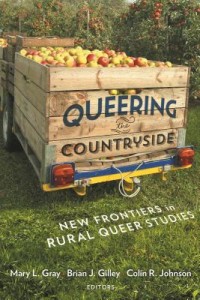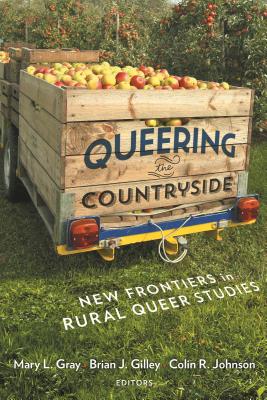 Queering the Countryside: New
Queering the Countryside: New
Frontiers in Rural Queer Studies
Edited by Mary L. Gray, Colin R. Johnson, and Brian J. Gilley
NYU Press. 416 pages, $30.
IN THE 1700s, the first century in which narratives about ordinary people were deemed important enough to write and to read, the Bildungsroman—the “novel of education”—was born. Back in the day, a typical novel of this type featured an achingly sensitive young man who felt stifled by his parents’ expectations and so fled to the nearest big city to discover the lures and dangers of the coffee houses, the theater, the political and artistic “underground,” and romance (not marriage) with “unsuitable” companions. When gay and lesbian “coming out stories” began to appear as a genre in the 1970s, they were really not as original as they seemed. Real and fictional characters had been fleeing the conservatism of the provinces to form new sexual identities in the wicked city for two centuries.
That the modern gay rights movement exists only in cities is an assumption that’s so entrenched as rarely to be questioned. Queering the Countryside is a quirky, interdisciplinary collection of essays that question this assumption of “metronormativity” while also challenging whether a city of strangers is always the best place for a gay or lesbian person to find true love. These essays discover important loci of “queerness” in places as far-ranging as male-only logging camps in the Old West and today’s teen bedrooms, where a lonely farm boy or girl can find companionship and even love on-line.
Surprisingly enough, the book begins with Horatio Alger, whose novels of self-improvement for boys are seen as an expression of the 19th-century American Dream. But Alger is revealed to have been a disgraced Unitarian minister who was found guilty of sexually molesting two boys, age thirteen and fifteen. His writing career followed his departure from the ministry, and the plots of his novels can be understood as thinly veiled expressions of his hidden desires. The young men in his fiction often travel to the frontier, away from the prying eyes of civilized society, and find experienced male mentors to guide them in their quests. In Alger’s worldview, the wilderness represented a realm of freedom and opportunity that the city foreclosed.
Another essay considers a collection of stories, The Faith Healer of Olive Avenue, by Manuel Muñoz (2007), about closeted Chicanos in rural California, where “deep green leaves hide meth labs.” Cultural identity, including sexual orientation, is shown to be as complex there as it is in San Francisco or L.A. Yet another piece reconsiders The Marvelous Land of Oz (1904) by L. Frank Baum, a sequel to his better-known The Wonderful Wizard of Oz. In the sequel, Oz is shown to be a rural “trans utopia” where characters are made of “queer assortments of things,” reproduction is non-biological, and a change of gender is treated as unremarkable. The image of the American West as a backward and homophobic region—a stereotype that was reinforced by the murder of Matthew Shepard in Wyoming in 1998—is considered and debunked.
The essays in Queering the Countryside seem to be directed to a variety of readers, and this diversity gives strength to the collection. As someone who remembers a time and place—small-town Idaho in the 1960s—when many housewives grew and canned their own vegetables and sewed their own clothes, I have reservations about the current assumption that women (and specifically lesbians) gain “independence” by finding big-city jobs that can pay for overpriced housing, restaurant food, and mass-produced goods. As radical thinkers pointed out when “gay rights” and “second-wave” feminism were new concepts, no one who is completely dependent upon the urban industrial economy can be a rugged individualist. The time has come to reconsider the countryside as more than simply a place from which to escape.
________________________________________________________
Jean Roberta is a widely published freelance writer based in Regina, Saskatchewan.






